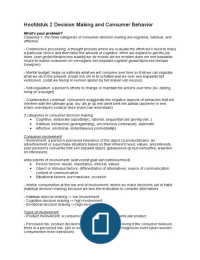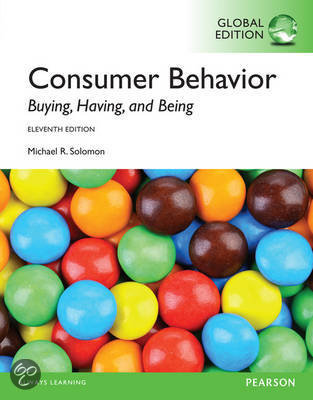Hoofdstuk 2 Decision Making and Consumer Behavior
What’s your problem?
Objective 1: the three categories of consumer decision making are cognitive, habitual, and
affective.
- Constructive processing: A thought process where we evaluate the effort we’ll need to make
a particular choice and then tailor the amount of cognitive ‘effort’ we expand to get the job
done. (een gedachtenprocess waarbij we de moeite die we moeten doen om een bepaalde
keuze te maken evalueren en vervolgens een bepaald cognitief gedachtprocess hieraan
toewijzen)
- Mental budget: helps us estimate what we will consume over time so that we can regulate
what we do in the present. (Helpt ons om in te schatten wat we over een bepaalde tijd
verbruiken, zodat we hierop in kunnen spelen bij het maken van keuzes)
- Self-regulation: a person’s efforts to change or maintain his actions over time (bv. dieting,
living on a budget)
- Counteractive construal: consumers exaggerate the negative aspects of behaviors that will
interfere with the ultimate goal. (bv. als je op een dieet bent het aantal calorieren in een
snack overdrijven zodat je deze snack kan weerstaan)
3 categories in consumer decision making:
Cognitive: deliberate (opzettelijk), rational, sequential (als gevolg van..)
Habitual: behavioral (gedragsmatig), unconscious (onbewust), automatic
Affective: emotional, instantaneous (onmiddellijk)
Consumer involvement
- Involvement: a person’s perceived relevance of the object (a product/brand, an
advertisement or a purchase situation) based on their inherent need, values, and interests.
(een persoon’s relevantie mbt een bepaald object, gebasseerd op hun behoeftes, waarden
en interessen)
antecedents of involvement: (wat vooraf gaat aan betrokkenheid)
Person factors: needs, importance, interest, values
Object or stimulus factors: differentiation of alternatives, source of communication,
content of communication
Situational factors: purchase/use, occasion
- Inertia: consumption at the low end of involvement, where we make decisions out of habit
(habitual decision making) because we lack the motivation to consider alternatives
- Habitual desicion making -> low involvement
- Cognitive decision making -> high involvement
- Emotional decision making -> high involvement
Types of involvement
- Product involvement: a consumer’s level of interest in a particular product
- Perceived risk: product decisions are likely to be highly involving if the consumer believes
there is a perceived risk. (als er een risico bij het besluitvormingproces komt kijken worden
consumenten meer betrokken)
, 5 types of peceived risk:
Monetary risk (financieel risico)
Functional risk (alternatieven)
Physical risk (fysieke kracht, gezondheid en vitaliteit)
Social risk (zelfvertrouwen en zelfverzekerdheid)
Psychological risk (voorkeuren en status)
- Brand loyalty: repeat purchasing behavior that relfects a conscious decision to continue
buying the same brand. (herhalingsaankopen die een weloverwogen keuze voor een product
of merk reflecteren)
- Mass customization: the personalization of products and services for individual customers
at a mass-production price. (massa personalisatie van producten (met een massa productie
prijs) voor individuele consumenten)
- Message involvement: media vehicles possess different qualities that influence our
motivation to pay attention to what they tell us. (betrokkenheid bij een bericht/advertentie)
(bv. print is a high-involvement medium, because he actively has to process the information.
TV is a low-involvement medium because it requires a passive viewer)
- Narrative transportation: people become immersed (ondergedompeld) in the storyline (in
other words: a message/advertisment is so involving that it’s hard to destract them from the
message)
- Variety seeking: the desire to choose new alternatives over more familiar ones (bv. omdat
iets nieuw is wil je het proberen
A marketer can boost a person’s motivation to process relevant information via one or more
of the following techniques:
Use novel (new) stimuli, such as unsual cinematography, sudden silences, or
unexpected movements
Use prominent stimuli, such as loud music and fast action, to capture attention
Include celebrity endorsers (mensen luisteren eerder naar bekende personen)
Provide value that customers appreciate (bv. een sanitair-producent zet gratis te
gebruiken toiletten neer op Times Square)
Invent new media platforms to grab attention (bv. trivia vragen op een Pringles bus)
Create spectacles where the message is itself a form of entertainment (maak een
show van de reclames)
- Situational involvement: takes place with a store, website, or location where people
consume a product or services. One way to increase this kind of involvement is to
personalize the messages shoppers receive at the time of purchase. (advertenties die
inspelen op je koopgedrag in de winkel/website. Bv. een aantal marketeers geven de
consument aanbevelingen voor producten n.a.v. wat ze in hun winkelmandje hebben)
Cognitive desicion making (1st of 3 categories of decision making)
Objective 2: a cognitive purchase decision is the outcome of a series of stages that results in
the selection of one product over competing others
- Information-processing perspective: view of decision making, where people calmly and
carefully integrate as much information as possible with what they already know about a
product, painstakingly weigh the pluses and minuses of each alternative, and arrive at a






